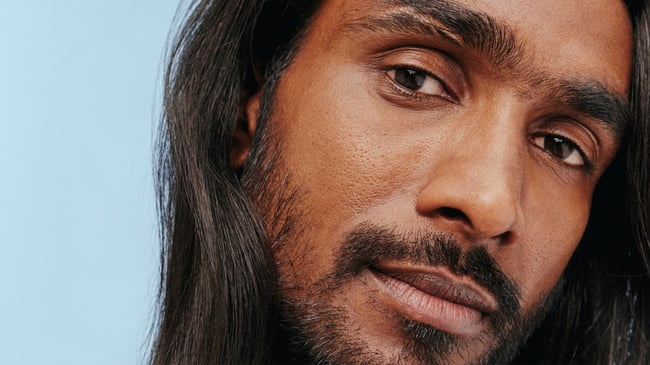

Seven Tips to Counter Greasy Hair
Photos Abaca
Words Anthony Vincent
Share the article on
Faced with shiny hair, our advice for a healthy scalp and smart hairstyle.
Often treated like the big bad wolf, sebum is not the enemy we think it is. The body produces it to protect the hair. Only when it is secreted in excess does it become a problem: suffocating the scalp and leaving greasy hair. Which in turn becomes flat and shiny, like Professor Snape in Harry Potter.
The cause of greasy hair
In a general sense, the hair is greasy because of everyday hygiene. The frequent use of unsuitable shampoos, pollution, anxiety, or the stress of the football league excite the sebaceous glands which produce excess sebum. Even freshly washed, the hair goes greasy fast. With natural fats, it soon returns.
Tip 1: Space out your shampooing
Resisting the urge to shampoo every day, to get rid of the hair’s shiny appearance helps rebalance sebum production. Using a gentle purifying, sulfate-free shampoo avoids attacking the scalp, which will then not need to fight back with fats. Of course, you are not guaranteed that a stick of butter will protect you from all assaults.
The Sebocytine active ingredient in a sebum-regulating agent derived from rosehip berry, contained in our gentle purifying shampoo, specially formulated from normal to oily hair. It allows treatments every other day, the first few weeks, and then every third day. The purifying properties of grapefruit, lemon, sage, and rosemary essential oils also gently purify the scalp to leave it clean and fresh. Little by little, you will leave the shampoo stage behind, because it already does the job so well.
Tip 2: Use a fortifying, hydrating conditioner
After rinsing off the shampoo, the conditioner can be applied to the wet hair for 2 to 3 minutes. You then have the time to soap up (while reflecting on Paul Pogba’s various hairstyle decisions) before rinsing for softer, stronger, and easily combed hair. The red ginseng in our strengthening conditioner stimulates the scalp and improves hair health. Kokum and shea butter nourish and soothe the scalp which then requires to produce sebum less. This will stop your scalp itching, making you less tempted to slip your sometimes dirty fingers into it. And in turn, your hair will become less greasy.
Tip 3: Rinse with cold water and towel dry
The hotter the water, the more it dries the scalp, stimulating the sebaceous glands that increase sebum levels. Rinsing out shampoo and conditioner with cold water prevents this from happening, and adds a shimmer to the hair. The cool shower makes the hair less dull.
The same goes for the hair dryer. The heat can attack the scalp, so squeeze out most of the moisture in a towel and allow the rest to air dry. This is more healthy for the hair. Dry hair, clear mind.
Tip 4: Less fingers, less fat
Excessively fiddling the scalp excites the sebaceous glands. When shampooing and conditioning, massage quickly to distribute the product. That should be enough, alternating with the palms of your hands so as not to stimulate sebum. The same logic applies during the day: When you have an itchy head, resist the temptation to scratch, or it will get greasy. Avoid touching your hair to spare it getting dirty, and transferring sebum from the hands.
Tip 5: Go for rinsable styling products when not using a shampoo
It’s hard to remove shampoo if you often use styling products – but not impossible. Some products can be rinsed off with clean water, so you don’t have to rely on shampoo. Our wax pomade offers a strong hold and matte finish that suits oily hair. The clay it contains absorbs excess oil to keep the hair looking clean.
Tip 6: Wash, comb, brush, and swap your pillowcase often
You might not think too much about it, but excess sebum can build up on the tools you use to style your hair. It is a shame to wash your hair, and immediately re-grease it with a dirty comb or brush. Soap them once a week to quell the problem. Your pillowcase also absorbs some of the sebum on shampoo-free days, and returns it to your hair. Changing it once a week makes all the difference, and even helps with clearer skin. Take the opportunity to completely change your sheets, too: dead skin can accumulate on the surface, turning your bed into a haven for bacteria. This will also allow your to vary your background for #IWokeUpLikeThis selfies.
Tip 6: Absorb excess fat with talcum powder or dry shampoo
In addition to all of these basic tips, there are two solid products that can take it further. Sprinkled sparingly on the roots, talcum powder absorbs excess sebum on days between a shampoo wash, and a comb or brush will do the job of removing white marks. Dry shampoo works on the same principle: sprayed from a distance of 20cm, it even gives the impression the hair was water-washed. Contrary to its name, it won’t wash the hair, but helps it last an extra day until you apply shampoo. The show must go on.
So, rather than wage a war of fats with aggressive daily shampooing, focus on moisturising and soothing the scalp so it produces less sebum. This will help you finally make peace with your hair.